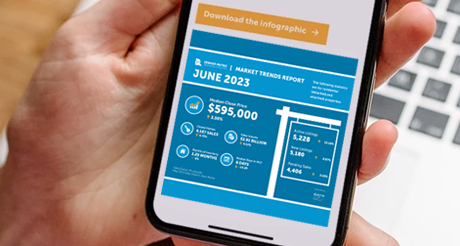Prepare to Buy a Home in 2023 | Guest Post
As we enter the home stretch of a turbulent year, amid the holidays, heading into the new year, let’s consider what’s in store for the 2023 real estate market.
One thing is sure: the market — much like the weather — will get a bit colder before it starts warming up again.
First, mortgage rates continue to hover around the low- to mid-6s due to the recent drop in the consumer price index (CPI) – revealing how the increase in the Federal Reserve's benchmark interest rate is having its intended effect of making the cost of borrowing so expensive that it slows down the economy.
Buyer activity is decreasing as a consequence. We're landing at the end of the year with the sellers, who would be buyers, deciding they don't need to buy right now after all. The simple fact is if sellers don't want to put their homes on the market, especially during this time of year, they won't, and the supply will constrict.
Even if the economic situation improves tomorrow, inventory will remain a major issue. New construction was disrupted by the rise in interest rates. Housing starts are down 8.8 percent from October 2021, according to the U.S. Census Bureau. Once the housing pipeline slows down, it takes time to get it flowing again.
Potential sellers locked in at a low rate won’t want to sell their home in a market like this. If anything, they will convert it into an investment and lay low while the rates are high. Additionally, many seniors delayed their move into assisted living centers due to COVID and didn't put their homes on the market at the expected time, resulting in further inventory reduction.
Nonetheless, come January 2023 we can expect a bit of a reset in the market. The typical seasonal pattern of inventory returning to a kickoff after the Superbowl and peaking in the summer. You’ll also likely see more homes on the market by February with a bigger bump March and April as rates continue their decent.
In other words, 2023 will be a transition for the housing market. The year when the wildness of 2021 and 2022 settled into a new normal.
How Macroeconomic Factors Are Influencing the Market
Federal Reserve Chairman Jerome Powell has signaled that the Fed will continue to increase its benchmark interest rate to temper demand for consumer goods, encourage savings and tame inflation. Depending on how the rate increases affect January CPI, mortgage interest rates will either go up or down.
The housing sector's dependence on interest rates meant it was the first sector to enter the recession. At the same time, that means it will be the first to emerge from the recession when the market transitions in 2023.
When we say transition, we aren't talking about a return to the wide-eyed shock of 2020, 2021 and early 2022. We won't see a flood of buyers taking advantage of 2-3 percent interest rates. Those buyers saw the opportunity and pounced. The situation wasn't “have to buy” or even “want to buy," it was, “I can’t NOT buy when money is this cheap.”
This is what's more likely to occur: as we begin to see the seasonality of Spring selling kick in next year, we could see rates in mid-5s by March. Mid-5s entice buyers with a need for stability and a strong desire to buy.
Want to Buy a Home in 2023? Start Looking Now
Here is what I anticipate happening throughout 2023: home prices are expected to drop through Q1, stabilize in Q2 as both buyers and sellers return to the market, and find a new normal in Q3 and Q4, leveling out to a 1-2 percent appreciation.
This means most sellers will return to the market around February or March 2023. Just as the typical seasonality kicks in, inventory will increase, demand will pick up, and interest rates will come down slightly.
Buyers willing to survey the market in December, January and February could be at a strategic advantage and have more negotiating power.
It's all about timing. Catching the market on the way up is much more affordable than entering after it's already hot. Remember: sellers only need two offers, and by March, two or three offers will easily be on the table.
Sure, those who enter the market early will be picking through a smaller inventory. On the other hand, the lack of competition will give them negotiating power that could result in:
- Price drops
- Free inspections
- Temporary (or permanent) rate buy-downs
- Getting locked in at an interest rate of 5 percent, lowering the chances of needing to refinance in the future
Waiting for prices to fall isn't a viable strategy. Jumping into the market now is.
Feel Empowered to Take Action
2023 will bring up some of the same emotions experienced throughout 2021 and 2022, but for different reasons. As real estate professionals, it is important to stay keenly aware of the buyer's psyche.
The largest age group for homebuyers is between 32 and 41, making up 25 percent of the market. For the last two years, they were priced out. Then, in the last six months, many gave up on their hopes of finding a new home as affordability created worry and fear. Considering all they've been through, real estate professionals need to remain sensitive to clients' needs so they can feel empowered to take action in 2023. It would be a mistake to wait for home prices to fall further rather than sitting down at the negotiating table before the markets rise.
In 2023, as the market continues to stabilize, there will be the opportunity to stay in the game to meet clients where they are and to help them capitalize on the wealth-building opportunities that real estate can provide.
The views, opinions and positions expressed within this guest post are those of the author alone and do not necessarily represent those of the Denver Metro Association of Realtors®. The accuracy, completeness and validity of any statements made within this article are not guaranteed. We accept no liability for any errors, omissions or representations. The copyright of this content belongs to the author and any liability with regards to infringement of intellectual property rights remains with them.
If you are interested in submitting a guest post, please contact Sarah at sgoode@dmarealtors.com.



